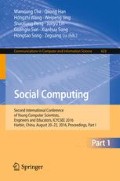Abstract
There exist two or more competing products in viral marketing, and the companies can exploit the social interactions of users to propagate the awareness of products. In this paper, we focus on selecting seeds for maximizing the competitive influence spread in social networks. First, we establish the possible graphs based on the propagation probability of edges, and then we use the competitive influence spread model (CISM) to model the competitive spread under the possible graph. Further, we consider the objective function of selecting k seeds of one product under the CISM when the seeds of another product have been known, which is monotone and submodular, and thus we use the CELF (cost-effective lazy forward) algorithm to accelerate the greedy algorithm that can approximate the optimal with 1 − 1/e. Experimental results verify the feasibility and effectiveness of our method.
Access this chapter
Tax calculation will be finalised at checkout
Purchases are for personal use only
References
Newman, M.E.J.: The structure and function of complex networks. SIAM Rev. 45(2), 167–256 (2003)
Newman, M.E.J., Forrest, S., Balthrop, J.: Email networks and the spread of computer viruses. Phys. Rev. E 66, 035101 (2002)
Chakrabarti, D., Wang, Y., Wang, C., et al.: Epidemic thresholds in real networks. ACM Trans. Inf. Syst. Secur. 10(4), 1–26 (2008)
Hosseini, S., Abdollahi Azgomi, M., Torkaman Rahmani, A.: Dynamics of a rumor-spreading model with diversity of configurations in scale-free networks. Int. J. Commun. Syst. 28, 2255–2274 (2015). doi:10.1002/dac.3016
Datta, S., Majumder, A., Shrivastava, N.: Viral marketing for multiple products. In: Proceedings of ICDM 2010, pp. 118–127 (2010)
Wortman, J.: Viral marketing and the diffusion of trends on social networks. Technical report no. MS-CIS-08-19, Department of Computer and Information Science, University of Pennsylvania (2008)
Domingos, P., Richardson, M.: Mining the network value of customers. In: Proceedings of SIGKDD 2001, pp. 57–66 (2001)
Kempe, D., Kleinberg, J., Tardos, É.: Maximizing the spread of influence through a social net work. In: Proceedings of SIGKDD 2003, pp. 137–146 (2003)
Durrett, R.: Lecture Notes on Particle Systems and Percolation. Wadsworth Publishing, Boston (1988)
Liggett, T.M.: Interacting Particle Systems. Springer, New York (1985)
Granovetter, M.: Threshold models of collective behavior. Am. J. Soc. 83(6), 1420–1443 (1978)
Schelling, T.: Micromotives and Macrobehavior. Norton, New York (1978)
Nemhauser, G., Wolsey, L., Fisher, M.: An analysis of approximations for maximizing submodular set functions—I. Math. Program. 14(1), 265–294 (1978)
Leskovec, J., Krause, A., Guestrin, C., et al.: Cost-effective outbreak detection in networks. In: Proceedings of SIGKDD 2007, pp. 420–429 (2007)
Chen, W., Wang, Y., Yang, S.: Efficient influence maximization in social networks. In: Proceedings of SIGKDD 2009, pp. 199–208 (2009)
Wang, C., Chen, W., Wang, Y.: Scalable influence maximization for independent cascade model in large-scale social networks. Data Min. Knowl. Disc. 25(3), 545–576 (2012)
Hu, J., Meng, K., Chen, X., et al.: Analysis of influence maximization in large-scale social networks. SIGMETRICS Perform. Eval. Rev. 41(4), 78–81 (2014)
Galhotra, S., Arora, A., Virinchi, S., et al.: ASIM: a scalable algorithm for Influence maximization under the independent cascade model. In: Proceedings of WWW 2015, pp. 35–36 (2015)
Shi, Q., Wang, H., Li, D., et al.: Maximal influence spread for social network based on MapReduce. In: Proceedings of ICYCSEE 2015, pp. 128–136 (2015)
He, X., Song, G., Chen, W., Jiang, Q.: Influence blocking maximization in social networks under the competitive linear threshold model. In: Proceedings of SIAM ICDM 2012, pp. 463–474 (2012)
Budak, C., Agrawal, D., El Abbadi, A.: Limiting the spread of misinformation in social networks. In: Proceedings of WWW 2011, pp. 665–674 (2011)
Carnes, T., Nagarajan, C., Wild, S.M., et al.: Maximizing influence in a competitive social network: a follower’s perspective. In: Proceedings of ICEC 2007, pp. 351–360 (2007)
Wu, H., Liu, W., Yue, K., Huang, W., Yang, K.: Maximizing the spread of competitive influence in a social network oriented to viral marketing. In: Li, J., Sun, Y., Dong, X.L., Yu, X., Sun, Y., Dong, X.L. (eds.) WAIM 2015. LNCS, vol. 9098, pp. 516–519. Springer, Heidelberg (2015). doi:10.1007/978-3-319-21042-1_53
Chen, W., Collins, A., Cummings, R., et al.: Influence maximization in social networks when negative opinions may emerge and propagate. In: Proceedings of SDM 2011, vol. 11, pp. 379–390 (2011)
Chen, W., Wang, C., Wang, Y.: Scalable influence maximization for prevalent viral marketing in large-scale social networks. In: Proceedings of SIGKDD 2010, pp. 1029–1038 (2010)
Long, C., Wong, R.C.W.: Minimizing seed set for viral marketing. In: Proceedings of ICDM 2011, pp. 427–436 (2011)
Acknowledgement
This paper was supported by the National Natural Science Foundation of China (61472345, 61562091), the Natural Science Foundation of Yunnan Province (2014FA023, 2013FB010), the Program for Innovative Research Team in Yunnan University (XT412011), the Program for Excellent Young Talents of Yunnan University (XT412003), Yunnan Provincial Foundation for Leaders of Disciplines in Science and Technology (2012HB004), and the Research Foundation of the Educational Department of Yunnan Province (2014C134Y).
Author information
Authors and Affiliations
Corresponding author
Editor information
Editors and Affiliations
Rights and permissions
Copyright information
© 2016 Springer Science+Business Media Singapore
About this paper
Cite this paper
Wu, H., Liu, W., Yue, K., Li, J., Huang, W. (2016). Selecting Seeds for Competitive Influence Spread Maximization in Social Networks. In: Che, W., et al. Social Computing. ICYCSEE 2016. Communications in Computer and Information Science, vol 623. Springer, Singapore. https://doi.org/10.1007/978-981-10-2053-7_53
Download citation
DOI: https://doi.org/10.1007/978-981-10-2053-7_53
Published:
Publisher Name: Springer, Singapore
Print ISBN: 978-981-10-2052-0
Online ISBN: 978-981-10-2053-7
eBook Packages: Computer ScienceComputer Science (R0)

